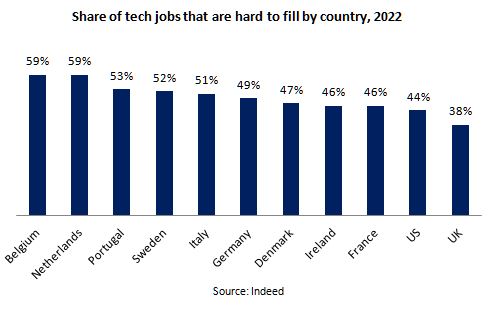In the UK, there were over a million job vacancies in the 3 months to July 2023, indicating that employers are finding it hard to fill roles, even in the midst of a cost of living crisis[1].

We’ve heard news stories of farmers losing crop yield due to a shortage of fruit pickers, of supply chain disruptions due to a lack of HGV drivers causing bottlenecks with delivery, and of cafes and restaurants shutting down because owners can’t find the staff. However, the research shows that hard-to-fill roles are also acute among high-skill STEM roles, particularly tech roles which are growing four times faster than the workforce as a whole, leading to an average of 173,000 vacancies per month.[2] This isn’t just a UK problem, but a problem across the EU and the US.
Despite the wave of tech layoffs this year, long-term demand for tech talent is not expected to abate. Across the UK, EU and US, the share of tech job openings categorised as ‘hard to fill’ increased in 2022 compared to previous years, with Belgium and the Netherlands experiencing the highest shortages.[3] This trend is expected to continue.
Given the shortfall of candidates, myself and my peers at Tech London Advocates[4] were somewhat surprised and concerned to hear from recent IT graduates attending a career workshop we ran earlier this year, how hard they were finding it to secure a job, and that some had stopped trying altogether and were considering roles in other sectors! These IT graduates had one thing in common. They were all women.
Recent attention has been drawn to retention challenges, following reports of women who do become tech professionals, leaving the industry in alarming numbers. For example, a US report from Accenture and Girls Who Code found that women are 50% more likely to drop tech roles before the age of 35.[5] In an industry suffering from a significant imbalance in gender representation, are we regressing on pipeline issues? Why are qualified young women getting turned off from even applying for tech roles?
During the workshop, we discovered three worrying developments.
1. Many young women downplay their skills and accomplishments
Several of the recent graduates expressed a lack of confidence in applying for tech jobs unless they felt they had all or nearly all the skills. In line with popular perception, many admitted they wouldn’t apply unless they believed they were a 100% match.
When Sheryl Sandberg published her book Lean In in 2013, a catchy finding mentioned in it started to turn into received wisdom: men apply for positions if they meet just 60% of the requirements, while women only apply if they meet 100% of them. It did not take long for journalists to reveal this claim was only based on a speculative comment made by a senior executive at Hewlett Packard – no quantitative data was used to generate this “fact”. However, whether fact or fiction, there is a lot of anecdotal evidence that women self-gate by stopping themselves from applying for highly skilled roles because they lack self-belief.
Doubts about their competency is a key concern and worth further exploration. However, I think it’s too easy and convenient to point to women’s apparent lack of confidence as the key explanation for their hesitancy in applying for roles. It creates the impression that women are to blame for their own under-representation. If women simply behaved more like confident men, then we wouldn’t have an issue. Voila! Problem solved!
Let’s not pathologise lack of confidence and blame “imposter syndrome” – a condition we never use for men. It’s important we highlight the years of social conditioning that often lead to girls and women setting much higher standards for themselves or leaving them feeling more modest about their own accomplishments. So whilst confidence-building exercises and coaching on writing a winning CV all help, we also need to raise awareness and identify strategies for addressing the structural roots to self-doubt in women.
2. Young women are put off by stereotypically masculine job descriptions for tech jobs
Many of the job descriptions for tech roles use very stereotypical masculine and corporate language, such as “must be results-driven”, or “we’re looking for a go-getter”, creating an image of the type of person the hiring firm is looking for, e.g. someone very competitive, which some candidates don’t easily relate too. The effect? They don’t apply.
Another problem flagged is that job descriptions can be written in a way that fails to attract applicants like them who have the skills but may not fully appreciate that they do. For example, asking for someone “who is highly analytical and numerate” can be off-putting, but asking for somebody “who can analyse data” is more appealing as more people are able to call on examples where they have analysed data.
Some graduates mentioned that job descriptions that insist on certain years of experience in a similar role is also a blocker and it serves to reinforce the “catch-22 dilemma” of needing a job to get the experience, but needing the experience to get the job. The lack of work experience affects both genders and it’s down to employers to provide internships, placements and voluntary work during university and ensure that female graduates are not missing out.
Employers also need to ask themselves as they write job descriptions and assess candidates, whether some of their assumptions, such as needing a certain level of prior experience, are still valid. Several key competencies can come from other environments such as voluntary work in the local community. Focus on candidates’ willingness to learn and grow rather than their sector experience.
3. Young women are concerned about algorithmic screening bias
When female IT graduates do apply for tech jobs, many told us they don’t make it through the first stage of CV screening and believe they are being screened out by algorithmic-enabled recruitment tools.
On the surface, CV screening tools that leverage AI bring a host of benefits to HR departments from reducing costs, freeing up time, speeding up the pace, and improving diversity by supposedly removing the implicit biases of hiring managers, but they are also getting a bad rap for reproducing and even exacerbating human biases if they are being trained on gender and culturally-coded words.
For example, these tools may look for characteristics the algorithm associates with productivity or success which may amplify bias toward specific segments of the population. These include sports that are more often played by men. Often, the screening tools are configured to find candidates whose backgrounds and experiences are comparable to those of the employer’s existing high-performing employees. If the existing employees are generally all men, then the technology is likely to end up finding carbon copies!
AI in the hiring process is still an emerging field but is likely to grow. Firms need to evaluate very carefully whether the input data used reflects a diverse workforce. If it does, a properly functioning AI tool should mimic that diversity in its results.
What next?
To remain competitive in technological growth and innovation, the UK must recruit and retain women for the fast-growing tech roles of today and the foreseeable future.
The findings from our workshop indicate that tech job descriptions are unwittingly creating barriers to a key source of talent – women. More work is needed to raise awareness among employers of the talent waste created by recruitment processes with in-built biases in job ads and CV screening.
Stereotypically masculine language and overly competitive requirements can alienate potential female candidates. Such descriptions can be off-putting for men too, but employers need to be mindful of the years of social conditioning that can lead to women self-imposing a much higher bar than what men are expected to achieve and not apply for roles because they believe they don’t measure up. Crafting inclusive job descriptions that focus on essential skills rather than intimidating qualifications can broaden the applicant pool and attract diverse talent.
It’s time to stop sucking at hiring and start building a tech workforce that reflects the full spectrum of talent and potential.
[1] https://www.ons.gov.uk/employmentandlabourmarket
[2] https://www.gov.uk/government/speeches/digital-secretary-michelle-donelans-speech-at-bloomberg
[3] https://stateofeuropeantech.com
[4] https://tlawomenintech.org/
[5] https://www.accenture.com/_acnmedia/PDF-134/Accenture-A4-GWC-Report-Final1.pdf









